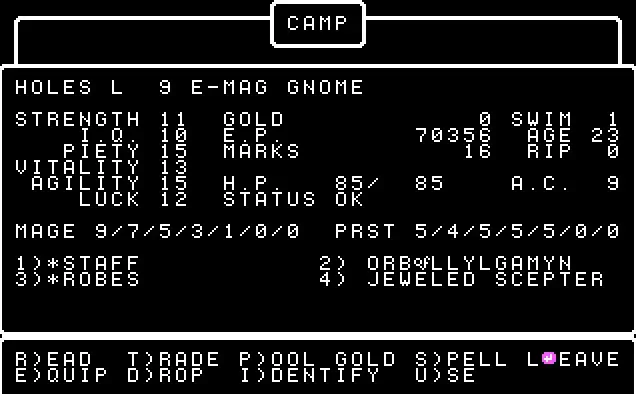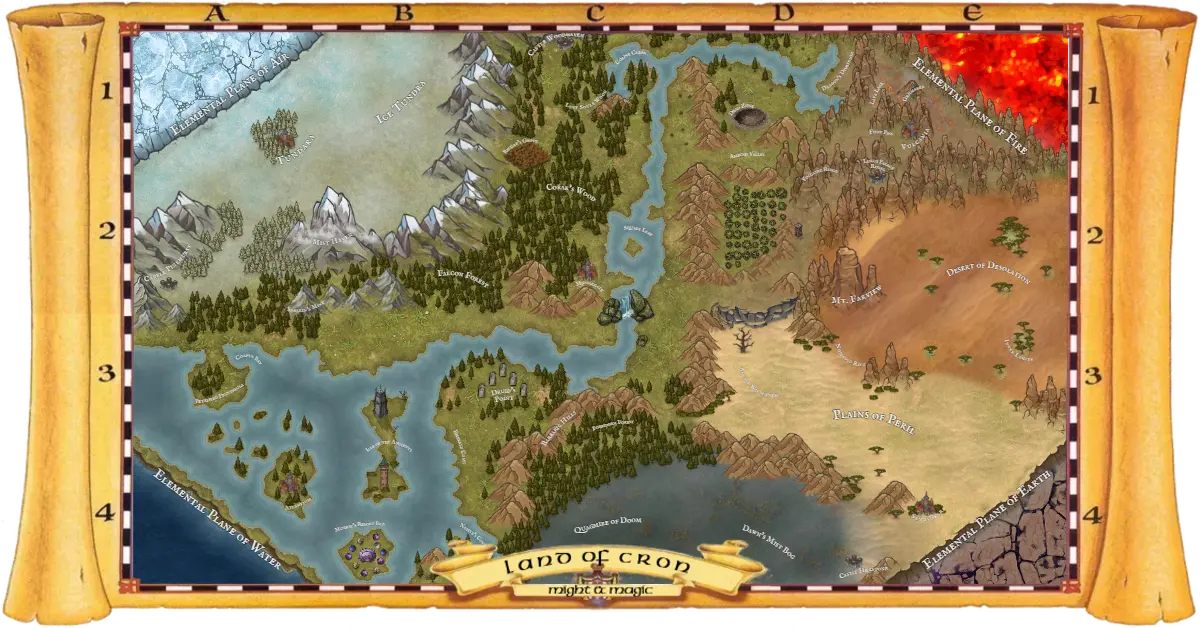The heart of the maelstrom gushes exemplar mechanics for turn based role playing games. We will see how the new features work and how they affect the gameplay and game difficulty, as compared to previous offerings in the series. We completed analysis while playing the PC Wizardry Archives version and after playing Wizardry I, II, III. All features discussed are exemplar mechanics in CRPG genre.
Expanded Battlefield
Wizardry I, II, and III all had a very small and predictable battlefield. There are two rows of characters making up a front-line and a back-line. Enemies can only reach the back-line of your characters with spells or by decimating the front-line. This creates relative safety for the back-line as not all enemies have spells. On the other side of the battlefield, the enemies form into numbered groups. Your front-line characters can attack all the enemy groups while your back-line is restricted to spell casting, to reach any enemy group. In the first Wizardry Trilogy, it is common to have pure-class rogues idle in combat, because they are too weak for the front-line and too spell-deficient for the back-line.
In Wizardry V, the battlefield has expanded considerably. Mechanics like Weapon Range, Ambush, and Spell Defense add depth and layers to the strategic landscape. This has ramifications in combat and also character development, let’s go.
Weapon Range
As of Wizardry 5, weapon tables have a Range value and some weapon attacks from the back-line can reach enemies. Bows of course, but polearms, morning stars, and staves can also reach. Close, Short, Medium, and Long are the weapon ranges. The enemies fill into numbered groups. Higher numbers indicating relative distance into the back field, out of reach to Close weapons. Character position as follows also impacts available targets.
| Character Position 1-3 | Weapon Range Value | Character Position 4-6 |
|---|---|---|
| enemy 1-2 only in reach | Close | all groups out of reach |
| all enemy groups | Short | enemy group 1-2 only |
| all enemy groups | Medium | enemy groups 1-3 |
| all enemy groups | Long | all enemy groups |
The significance is huge. A Mage with a Staff can now swing at Groups 1-2. A Thief can now shoot a bow at Groups 1-3 from the back-line. A Priest or Bishop can swing a morning star at Groups 1-2 from the back. This is noticeable when grinding experience, “mashing enter” can now queue up 6 attacks
Naturally, the enemies extend their reach as well in Heart of the Maelstrom. The fragile mage is no longer safe in the back-row cowering behind steel. New strategies and character development opportunities emerge. For example, try a Mage that starts out as a Priest first, primarily for the much-increased hit point totals. Off to the character development page if you like further digression.

Hide/Ambush/Steal
Rogues and Ninjas can take a turn to Hide themselves while in combat. Hidden characters are not prioritized by enemies in the normal flow of combat. However, a revealed character will be a prioritized target for the rest of the combat. There are a few strategic reasons to hide. Firstly, when your hit points are low and you want to try and stay clear of combat. This will work somewhat, but enemies have a slight chance to reveal hidden characters. Further, enemy mages that are lighting up the battlefield with area-of-effect spells will certainly find a hidden character. The second reason to hide is so that your character can steal items and gold from unsuspecting foes. This can be profitable and also has questing value as some plot items are expensive to actually buy from NPCs.
The final reason to hide is to ambush. A hidden character can ambush for bonus damage on their turn. An ambush can target one from any enemy group and from any character position. A character can ambush with any weapon they can wield. Ambushing has a high probability of revealing the hidden character, however, high-level ambushers may stay hidden against low-level foes.
Foes Reach
The foes in the maelstrom also have new abilities. Large characters, such as giants, may attack any character position, having limbs able to reach or step over defensive lines. Incorporeal types are not constrained by the walls of the dungeon and so they can reach back-line characters. Further, enemies can wield weapons with reach such as polearms and bows.
Spell Defenses
Spell defenses are often overlooked, in favor of the flashy damage spells, but consider not all fights end after the first round. Sometimes you are not able to dispatch all the mages before they have a chance to wiggle their fingers. As waves of fire sweep through the ranks of your characters you may consider the folly. A prudent mage will erect magic screens around the party and fizzle fields around enemy casters.
Magic Screens
CORTU is the spell for Magic Screen. CORTU is cast upon the character party and stands to prevent incoming spells from landing. A magic screen has hit points in a sense, depleted as it takes damage. Further, CORTU casts will stack upon the screen adding to the strength. Since magic screens are cast upon the party, there is no opportunity for the enemies to resist the effects. They must blast through it. Magic screens do not deter melee weaponry.
CORTU is a combat timed spell, as such, the effects dissipate while out of combat and characters must erect the defense once in combat. It is important to have spell casters with high AGI to raise a strong screen fast when combat begins. It is more efficient to shield it rather than heal it.
Fizzle Fields
BACORTU is the spell for Fizzle Field. BACORTU is cast upon enemy groups and so each member of the group will have a chance to resist the effects of the spell. Once a fizzle field lands on an enemy, that enemy’s spell casting will be prone to disfunction. Their spell cast might simply fizzle or blow up in their face. Fizzle field strength is relative to the level of the field caster.
Anti-Magic
PALIOS may dispel magic screens and fizzle fields. This is incredibly handy when you come upon a horde of enemy mages hiding behind their own array of screens. Fear not, challenge-seeker, for the enemies can also cast PALIOS on your defenses.
Control Spells
While not all-new in Wizardry 5, I would like to call focus to some very useful spells that sit outside of the pure damage spell set. These spells can also help reduce the incoming damage that your characters will face. Check out the full spell list over here.
Spell List
| Spell Word | Translation | Description |
|---|---|---|
| KATU | Charm Group | This Level II Priest spell will prevent a group of monsters from attacking your characters. They will instead look around and become distracted from the combat situation. This will also make them easier to hit with melee weapons. |
| MONTINO | Silence Group | This Level II Priest spell has a silencing effect on a group of monsters. All spell casting in Wizardry has a vocal component and so a silenced group of enemy mages will be forced to swing their staves. |
| HAKANIDO | Magic Drain | This Level III Priest spell attempts to drain the monster of high level magic power, reducing the level of spells that it is able to cast. |
| MAPORFIC | Party AC reduction | This indispensable group buff lasts the whole expedition, until the characters return to the castle. A Level IV Priest spell that is always worth casting as you set out on new expeditions. This spell will reduce the AC of the whole party by -2, which is a good thing in Wizardry mechanics. |
Summon Spells
Summon Spells are new and give both spell schools a way to add groups of friends to the battlefield. Summoners do not get to choose what they summon, but the summoned may include relatively weak skeletons or strong demons. The summon spells are included here as magic defense because a primary function of summoned groups is to absorb damage. To be a target of enemy spells and attacks.
NPC and Chat
Another new feature in the maelstrom is the presence of NPCs that will talk, trade, and fight if so prodded. Trading with NPCs allows for players to unburden themselves of “sell trash” without making a trip all the way back to the castle. Trading also allows for story advancement by hiding quest items with NPC, behind keywords. Keywords that you may learn from other NPCs or from lore littered throughout the maze. Chatting with NPCs requires free-form text entry, void of multiple-choice. No color coding to hinting at slant to good or evil, just a flashing prompt.
Picking Locked Doors
Locked doors exist in the dungeons. These doors have no keys to be found; they can only be opened by Thief, Ninja, or the Level II Mage spell, DESTO. This mechanic adds class utility but the designers tend to use it as a level gate. Access to rooms and encounters now limited by the rogue, ninja, mage level.
Swimming
Swimming skill is something exciting. Not for the rewards that can be gained nor enjoyment from exploring the depths of a pool. The excitement about the swimming skill is that this is the first time a skill in Wizardry will increase with use. Skills being raised with use becomes a key facet of later Wizardry games in the series, and it started here. Arena, the first Elder Scroll game, also had skill-use leveling but not until 1994.
Save
This is effectively a permadeath nerf.. now, you need not rely on the unreliable resurrection system. Save feels like floppy swords and may have broken the fear and risk normally associated with venturing into the Maze. If there is no palpable fear in exploring the depths of the maze, is it still Wizardry? It is still Wizardry of course, but it has adapted to a wider audience and lost something here, in my opinion.
Innovation in turn based role playing games
In Wizardry V: Heart of the Maelstrom, the gameplay evolves significantly from its predecessors, offering a revamped battlefield experience. With the introduction of weapon ranges, the game deepens tactical combat, allowing characters and foes to attack from various positions. This change, alongside new mechanics such as Ambush and Spell Defense, compels players to rethink traditional strategies. New strategies emerge particularly in the deployment of spell casters and rogues, whose roles become more versatile.
Stealth tactics and expanded enemy capabilities, add a layer of complexity to encounters. Spell defenses become a strategic cornerstone, emphasizing the importance damage mitigation over endless healing. Additionally, the game debuts summon spells, further diversifying combat options.
Non-combat features also see improvements, with the inclusion of NPCs that offer trade, conversation, and combat interactions, the introduction of skills that improve with use—starting with swimming—and an auto-save feature. Wizardry V not only innovates within its series but also sets a precedent for character skill development and interactive gameplay features in turn based role playing games.
I love it all, except for auto-save.
All rules discussed considering the official manual.




